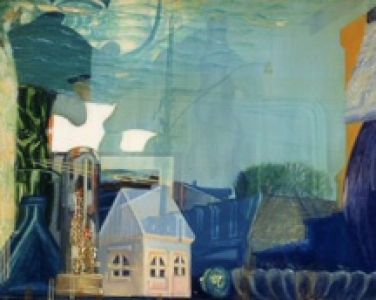Past Exhibition
Storefront
Katharine Harvey
February 2004
The recent work of Katharine Harvey peers into the storefront windows of her Toronto multi-cultural neighborhood. A world of porcelain knick knacks, glass bowls and glass shelving, a reflection on light and transparency, both interior and exterior.
The window display, that repository of possession and desire,mediated by glass and money. A consumptive arrangement, transcending the pedestrian and prosaic to flights of fashion fantasy and longing. The window enclosure is the other world and the glass, the portal of possibility accessing the desirable.
The exhibition is comprised of two distinctly different mediums, paint on canvas and the lenticular photograph, the latter being a Plexiglas surface incised or faceted to create a multi lens viewing and thereby creating the illusion of movement and three dimensional space. The two expressions of a similar subject matter present distinctly different vantage points on a consumer motif, yet what is apparent in both mediums is the layering of images from the distant depths up to the surface. This analogy to water and the penetration of surface is a theme running through the show, in some works more apparent than others.
The play between the two surfaces of water and glass is reinforced by the inclusion of roiling waves and model ships and in one painting the literal transformation of glass window surface into ocean surface.
Whether Harvey projects the shift of either glass or water or both, as the boundary between worlds, positions the viewer as the one gazing into the other, the dream the allusion, with our own reflection as the missing component. Simone Weil the French theologian suggests that the daydream is a diabolical crime to self realization and god. The nostalgic reflection or projection of longing, discards the present and consequently, the loss of self.
What are we to infer from these images, an accomplished illusionistic rendering upon closer visual inspection (as we approach the window) reveals less and less, dissolving the dream to a prosaic painterly gesture.

